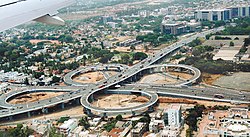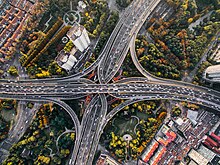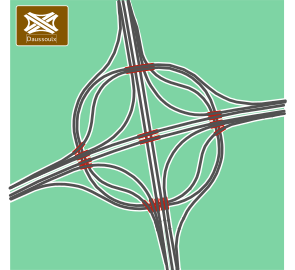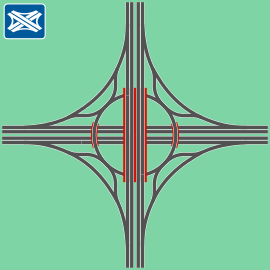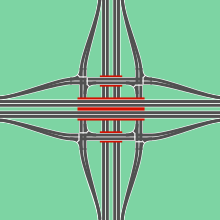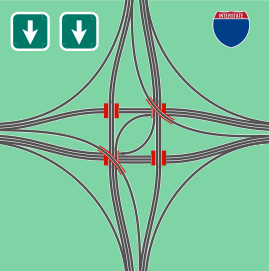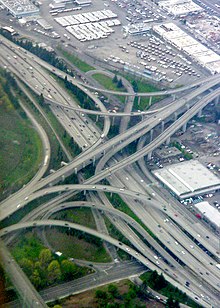Motorway junction
A motorway junction (symbol in Germany and Austria:) ![]() is a plan-free junction with mostly two intersecting motorways , more generally with at least four linked motorway arms.
is a plan-free junction with mostly two intersecting motorways , more generally with at least four linked motorway arms.
introduction
In the German motorway network there are 138 interchanges. At least four-armed motorway junctions are referred to there as motorway intersections, three-armed ones as motorway triangle or motorway fork. Arms for connecting a subordinate road do not count here. For example, a structure that is structurally equivalent to a four-armed motorway junction with such an arm is only referred to as a motorway triangle. An example of this is the Jackerath motorway triangle . Here one arm represents the Jackerath junction. With two such arms, one speaks of only one junction. An example of this is the motorway junction Leipzig-Süd , which will only be dedicated as a motorway junction after the conversion and upgrading of the intersecting motorway-like road to the motorway. In the past, the latter construct was sometimes only referred to as a cross instead of a motorway junction when connecting a motorway-like road and announced on signs with the cross symbol. One example of this is the Wilhelmshavener Cross . In North Rhine-Westphalia , on the other hand, as in other federal states, such crosses are successively renamed as junctions after a decree by the State Ministry of Transport in 2004 . (Name change, no cross symbol, signposting in yellow instead of blue)
The terms cross, triangle and branch are not used in Austria and Switzerland . In Switzerland they are collectively called branching . In Austria the 12 existing nodes are called . The only motorway junction in the national road network in Switzerland in the sense of the German definition is the Limmattal junction . However, when national and cantonal highways cross, there are also other crosses.
In Germany, Austria, Switzerland and the Benelux countries, junctions and motorway junctions have names. For the latter, however, this usually does not apply in France. There, the signs only show which highways intersect.
General functional principle
Motorway junctions are designed in such a way that both traffic crossing and traffic turning right or left can pass the cross without stopping due to traffic. This avoids accidents and traffic jams . At the same time, all road users, particularly traffic turning off, can maintain a relatively high speed.
In the case of two intersecting streets, which can be driven in both directions, eight connecting ramps are necessary in order to be able to reach any further direction from any direction without any height.
Components
Depending on the design, a cross has the following parts:
Entry and exit areas
The entry area (entrance) to the motorway consists of the acceleration lane and connects the distribution lane or the connecting ramp with the motorway. Similarly, the exit area (exit) consists of the deceleration lane . Normally, each directional lane has an entry and exit area. These areas are designed in such a way that traffic on the motorway is impaired as little as possible. Due to the possibility of acceleration or braking in the entry and exit areas, the vehicles can drive on the motorway at any time, adapted to the traffic flow.
Entrances that increase the number of continuous lanes result in lane addition ( lane addition). In contrast to this, a reduction in the number of continuous lanes when exiting is referred to as lane subtraction ( lane subtraction).
Distribution track
The distribution lanes establish the connection between the entry and exit areas and the connecting ramps. They are necessary so that there is only one entrance and one exit on the motorway, which increases traffic safety and the efficiency of the motorway junction. Normally, at least two connecting ramps branch off from a distribution track. Only in special cases is there no distribution lane because the junction has several entry or exit areas or there is only one connection in one direction. The cloverleaf has the most elaborate design, with two outgoing and two incoming ramps as well as an entrance and an exit.
Intertwining routes
The entry and exit traffic of a motorway junction intersect on interwoven routes: vehicles coming from the left switch to the right lane and vice versa. Interconnections can only take place between two single-lane carriageways, provided that the interlaced route does not have lengths in the range of kilometers ( parallel unbundling ).
When there is a high volume of traffic, short interwoven stretches are often the focus of accidents , as there is very little distance between them.
Connection ramps
The exits and entrances are connected with each other by means of connecting ramps. A distinction is made between direct, semi-direct and indirect connecting ramps for the three basic forms, which are decisive for the design of the motorway junction. However, alternative names are also used, which can cause confusion , especially with the direct ramp :
| Description here and in the article connecting ramp |
alternative name | features |
|---|---|---|
| Direct ramp | Tangential, tangent ramp | No other lanes are crossed. The change of direction is carried out immediately. With a right-angled cross, the curve is no more than 90 degrees. |
| Semi-direct ramp | Overfly, direct ramp | Other lanes will be crossed. The change of direction is achieved via slight “detours”. With a right-angled cross, the curve is more than 90, but less than 180 degrees. |
| Indirect ramp | Loop ramp, ear | The change in direction is achieved by taking a long curve in the opposite direction (i.e. turning left through a long right curve). With a right-angled cross, the curve is 270 degrees. |
Overpass structures
The plan-free execution of junctions can only be realized with the help of overpass structures (bridge structures). They are the biggest cost factor at a motorway junction and therefore an important aspect when choosing the design. In addition to the number of structures required, the span, length and height are also relevant. Simple overpasses only bridge one carriageway, while very complex structures can support and bridge several carriageways and can even serve to cross several other overpass structures.
Designs
There are different basic forms of motorway junctions. The differences lie in the space required, the possible speeds when changing the motorway and the construction and maintenance costs due to the effort or number of bridges required. The situation for driving straight ahead and turning right (when driving on the right) is relatively unproblematic and uniform. In particular, turning in the opposite direction requires structural effort; the main differences between the standard forms lie in the solution to this problem. The angle at which the motorways intersect is also essential for the design chosen. Between the basic forms of the motorway junction there are also mixed forms or special forms, such as B. the Sonnborner Kreuz or the AK Kaiserberg .
To simplify typing, the different types of construction are given designations that are derived from the shape that these traffic structures have when viewed from above.
Shamrock
The clover leaf is the oldest form, spread around the world and the most common in Germany. Such a cross consists of four direct ramps and four three-quarter circle arcs, the so-called ears . It requires relatively little space and only a single, relatively short bridge structure - the connecting ramps manage without bridges. In addition to the direct method, a cloverleaf also offers an indirect method of turning right, in which three of the four ears are passed through one after the other. Turning is possible by driving through two consecutive ears.
A major disadvantage of trefoil crosses is their poor performance. The performance limits arise firstly from the narrow radii of the ears of typically 40 to 50 meters, which only allow low speeds, and secondly from the shortness of the necessary interweaving distances between the ears. Here, the safety distances between the vehicles are systematically undershot . When the workload is high, backwater can easily occur. This disadvantage is countered, for example, at the Frankfurter Kreuz , which was designed in this design, in that the entrances and exits of the ramps do not merge, but are separated from one another by further bridge structures.
In order to keep the entanglement away from the flowing traffic, turning traffic is routed on separate entanglement routes, which, however, makes the bridge structure larger and more expensive. If a cloverleaf is subsequently disentangled, the original interlacing can be used as an additional lane.
Modifications
Enlarged ear for higher speed (often used, e.g. at Leipzig at the Schkeuditzer Kreuz before the renovation 2000-2003)
Unwoven clover leaf to reduce the number of lane changes (used in Frankfurt , Cologne-West and Aachen , among others )
Clover leaf with auxiliary ramps, so that it can be extended later without slowing down in a jam (used in Moscow at the MKAD )
Performed half cloverleaf : an incomplete cross with only four ramps (applied at Dreieck Darmstadt )
Cloverleaf with multi-lane semi-direct ramp (retrofitted in Kamen and Stuttgart, among others )
Cloverleaf with semi-direct ramps (design of the Oberhausen-West motorway junction )
Mixed form of clover leaf and Maltese cross
Shamrock with a semi-direct ramp
The Kamener Kreuz has been a clover leaf with a semi-direct ramp since August 25, 2009. This was necessary because the traffic between Hanover and Cologne had increased significantly and there were traffic jams and accidents every day. Until then, the motorway junction was a classic shamrock. The Stuttgart interchange , the Münster-Süd interchange and the Neufahrn interchange are of the same principle. The semi-direct ramp requires two more overpasses, it is (like the opposite direction) designed with two lanes. There is an increase in capacity in a fork and a partial unbundling.
Executed half leaf clover
This is an incomplete cross. It has only four ramps and is a semi-connection point for the motorway junctions. As a result, not all directions are passable. This design is used when there are other traffic nodes in the vicinity that cover the needs of the missing directions.
Shamrock with internal semi-direct ramps
A special form of ½-leaf clover, ¼-turbine and ¼-Maltese is a cost-optimized design for the bridge surfaces. Here, space is saved by two additional throws. In principle, such a cross consists of two motorway forks, whose bridges are also used and the remaining ramps are designed as cloverleaves. There are two ears that are diagonally opposite each other. Two semi-direct ramps running in parallel use common throws. In this section there is apparently left-hand traffic. By replacing the other two ears, a completely unbundled traffic flow is created, the optimum performance of which lies next to the straight-ahead directions on the forks. The Oberhausen-West motorway junction and the Graz-West motorway junction have this design. It is ideal in Oberhausen, as the west arm runs to the southwest, as well as in Graz due to the acute crossing angle. The anti-parallel ramps can make a glare protection fence necessary.
In the greater St. Louis , USA intersect on the historic Route 66 , the merged today Interstates 55 and 70 with Interstate 255 in '' 22 38 ° 40 N , 90 ° 1 '47 " W in leitplanke loose design a so-called Clover stack and in Flint , Michigan interstates 69 and 75 at 42 ° 59 '5 " N , 83 ° 44' 0" W . In Great Britain at Wokingham, west of London , about 10 km before Reading , the M4 crosses with the A329 at 51 ° 25 ′ 52 ″ N , 0 ° 51 ′ 18 ″ W and at Uxbridge the M25 crosses with the M40 at 51 ° 33 ′ 39 ″ N , 0 ° 31 ′ 53 ″ W in left-hand traffic . In the south of Moscow to cross at 55 ° 34 '34 " N , 37 ° 35' 48" O MKAD Vnutrennyaya Storona and Varshavskoye shosse. In Japan , south of Tokyo , to the west of Yokohama , the Yokohama New Way crosses with the Hodogaya Bypass at 35 ° 27 ′ 1 ″ N , 139 ° 34 ′ 11 ″ E in left-hand traffic. In District Xizhi of the city New Taipei City ( Taiwan ) crosses the Formosa Freeway the mountain highway about 15 km off the Pacific coast at 25 ° 4 '22 " N , 121 ° 38' 44" O . In Chengdu ( People's Republic of China ) intersect the G5 and G4201 at 30 ° 45 '29 " N , 104 ° 10' 1" O . Also located in China, in the province of Shaanxi in Pucheng crosses to 34 ° 54 '52 " N , 109 ° 38' 45" O G5 with the Weipu expressway.
Clover leaf with left connection
If, as with the Gothic cross, left exits and entrances are transferred to the clover leaf design, more space and a uniform speed range are required. The bridge area is divided into four bridge structures. Without further overpasses, two of the indirect ramps become direct and create a complete unbundling of the traffic flow. The use of this form is based on the fact that on the interstates outside of metropolitan areas there are no central barriers by spatially separating the directions of the lanes. In the half of the USA closer to the Atlantic, this type of construction occurs 20 km southwest of Baltimore . There, the cross Interstate 95 with the MD-SR-32 at 39 ° 9 ' "30 N , 38 76 ° 49'" W . Halfway from Pittsburgh to Columbus near Cambridge in Ohio , Interstates 70 and 77 intersect at 39 ° 59 ′ 55 ″ N , 81 ° 33 ′ 32 ″ W in the same design. In Brighton Township in Michigan the Interstate 96 intersect and US-24 at 42 ° 31 '27 " N , 83 ° 45' 16" W . North of Des Moines , Iowa , Interstates 35 and 80 meet at 41 ° 39 ′ 8 ″ N , 93 ° 34 ′ 33 ″ W in a modified form.
Maltese cross
The Maltese cross has the advantage over the shamrock that less space is required and at the same time high speeds can be driven. However, a very complex bridge construction is necessary in the middle of the cross, since at least four carriageway levels are superimposed here. In combination with more than four-armed nodes, more superimposed levels are required, which corresponds to a height difference of 30 m or more in the highest bridge structures without civil engineering.
An almost symmetrical example of a Maltese cross is the Knooppunt " Prins Clausplein " (A 4 / A 12) near The Hague in the Netherlands . In Great Britain, the intersection of the M 4 motorway with the London Ring is designed as a Maltese cross.
The only motorway junction in Germany built as a Maltese junction is the Wetzlar junction ( A 45 / A 480 ). However, its capacity does not come into its own, as the crossing A 480 is only short and will not be further built in the northeast. The Würzburg-West motorway triangle ( A 3 / A 81 ) would be a second example if the A 81 had been built to the north there. The Köln-Ost motorway junction ( A 3 / A 4 ) has three Maltese branches and a clover leaf loop.
For the conversion of the Leverkusen motorway junction , which connects the motorways 1 and 3 and is currently designed as a clover leaf, a conversion to the Maltese cross is under discussion (as one of 2 possible variants).
A disadvantage besides the large bridge areas of the Maltese Cross is that it cannot be used for turning. In the USA, this disadvantage is countered by an increased density of junction points, which also reduces the travel distances.
In the USA it is referred to as a stack in allusion to the side view and is the most commonly used form there, along with the clover leaf, as it can be driven through without changing speed.
|
The "High Five Interchange" in Dallas
The Maltese Cross and Volleyball for Frontage Roads has five floors:
as well as the single-lane Carpool lane Built between 2002 and 2005 and in operation 13 months earlier than planned. 32 ° 55 '27 " N , 96 ° 45' 49" W. |
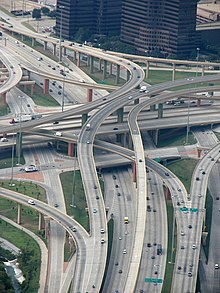
|
High Five Interchange
In the metropolises of the US state of Texas, the Maltese cross is the standard in combination with volleyball and is known as the "High Five Interchange" . The motorways, which can be up to ten lanes in each direction, are connected via partially single-lane ramps of a Maltese cross with hard shoulder. This relationship arises because the density of motorway junctions increases up to eight kilometers. The many junctions, the density of which exceeds one kilometer, are linked to the motorway via separate , parallel feeders (the Frontage Roads ). They are connected to the respective motorway junction via volleyball. This creates a street stack with five floors.
turbine
The turbine is characterized by the fact that the ramps are introduced behind the motorway junction and has the advantage that, like the Maltese Cross, high speeds can be driven here, while at the same time not so complex bridge structures are built, but five or nine pieces. The space requirement is slightly larger than with the clover leaf, is fully braided and can have multi-lane ramps.
This form is found relatively often in Great Britain (on the London ring road at Thorpe Interchange (junction with M 3 ) or Theydon Interchange (junction with M 11 )), and in Belgium - e.g. B. two crosses of this kind in Zaventem near Brussels. There the distribution circles, which are also popular there, were unbundled in this way.
Another turbine in Belgium is the junction Daussoulx, just north of Namur , at 50 ° 31 '16 " N , 4 ° 52' 51" O . This is where E42 and E411 intersect . It is slightly larger with a diameter of around 500 m and has internal direct ramps. This means that the semi-direct ramps can also end on the inside, and in principle only five bridges are required. The respective detour of the destination to the left is just under a kilometer. This design can also be found in the USA, for example in Texas on the way to Amarillo . At 35 ° 11 ′ 34 ″ N , 101 ° 50 ′ 14 ″ W , Interstates 27 and 40 cross each other as well as US-60, 87 and 287, which are on the same route.
In Germany there are only mixed forms. The Duisburg-Nord junction is a turbine with an indirect ramp, the Stuttgart-Degerloch junction ( Echterdinger Ei ) was converted from a cross with a roundabout into a mixture of turbine and windmill in 2002/2003.
A reminiscent of the turbine form are the mouths of the French motorway A46 and A47 to the Route A7 , south of Lyon at Ternay (Rhône) at 45 ° 35 '21 " N , 4 ° 47' 54" O . This cross is incomplete because it does not have an east-north ramp. Since the west-north ramp has two lanes, the south-west ramp has been overturned and the flow of traffic has been unbundled. This spaghetti knot would have managed as a double trumpet with less bridge area.
In the north of the Nagoya metropolitan area , the Nagoya Expressway No. 16 and Nagoya Loop Road No. 2 at 35 ° 13 ′ 18 ″ N , 136 ° 51 ′ 18 ″ E as a turbine over a volleyball . This forms the counterpart to the high five.
Special and mixed forms of turbine crosses
½ clover leaf + ½ turbine is partially disentangled, has low capacity on the indirect ramps.
Is widespread in China and the USA and the design of the former Mönchengladbach-Wanlo motorway junction before a motorway branch was closed.¼ clover leaf + ¾ turbine is fully braided and space-saving, has tight curves.
Is to be found in the USA and often in Chinese metropolises as well as Knooppunt Amstel near Amsterdam and as the Duisburg-Nord motorway junction .
Windmill

With the design of the windmill, all left-turning ramps are guided directly, but aligned so that they all pass through the main intersection structure once. Higher speeds are possible than with the clover leaf, but lower than with the Maltese cross or the turbine. Five bridge structures are required. The windmill cannot be used to turn either. Until 1997 the Vaanplein motorway junction was a windmill in the Netherlands.
Mixed form of shamrock and windmill
The windmill can hardly be found in its pure form. For this purpose, a modified windmill, which is a mixture of a clover leaf and a windmill, was often built. This form requires three throws and is completely disentangled. Examples of windmills with indirect ramps are the motorway intersections Bonn / Siegburg , Herne and Mönchengladbach or the motorway intersection Breitscheid (right in the picture).
In the USA, the design can be found several times in the Los Angeles area as far as San Diego : For example, the intersections of Interstates 10 and 110 in Los Angeles at 34 ° 2 ′ 17 ″ N , 118 ° 16 ′ 26 ″ W , the interstates 110 and 405 between Gardena , Torrance and Carson at 33 ° 51 ′ 24 ″ N , 118 ° 17 ′ 5 ″ W , at 33 ° 56 ′ 28 ″ N , 118 ° 5 ′ 48 ″ W of the intersection of Interstates 5 and 605 between Santa Fe Springs and Downey .
As in the first example in Los Angeles, a further variant in the USA is the left-hand entrance of the windmill ramps. This only saves bridge space if the lane directions are sufficiently separated from each other. This form is also unbundled, but distributes the oncoming traffic better and is the more common variant in the USA. West of Baltimore at Arbutus (Maryland) 39 ° 14 ′ 7 ″ N , 76 ° 42 ′ 36 ″ W intersect Interstates 95 and 195 , in Reno (Nevada) Interstates 80 and 580 at 39 ° 32 ′ 14 ″ N , 119 ° 47 '17 " W . In Murray, Utah, near Salt Lake City ( 40 ° 38 ′ 9 ″ N , 111 ° 54 ′ 19 ″ W ), Interstates 15 and 215 . At 35 ° 4 ′ 21 ″ N , 90 ° 1 ′ 38 ″ W in Memphis, Tennessee , Interstate 69 changes the shared route when Interstate 55 and 240 meet . In Georgia in Atlanta are three of these transport nodes: 33 ° 37 '59 " N , 84 ° 24' 4" W , in Sandy Springs , 33 ° 54 '42 " N , 84 ° 21' 25" W , at Clarkston : 33 ° 48 '58 " N , 84 ° 15' 5" W .

Roundabout
A special form of motorway junction can be found a few times in Great Britain and the Netherlands .
For turbine converted roundabout
For dual trumpet converted roundabout
Naturally, high speeds are not possible in the roundabout. As with the clover leaf, it is possible to change in any direction of travel, including "turning". Often the ramp leading in the right direction is also led outside the roundabout in order to relieve the traffic there. This design also makes it possible to link additional connections or more than two motorways with one another without great effort, provided the circle is large enough. The main difference is that these are fast roundabouts , so-called distribution roundabouts . These have no stop points, but rather interweaving strips. Since these are often very short, they are the main accident areas. If they are large and have multiple lanes, they can be converted into a turbine with little effort. This frees the transport hubs at the cost of not being able to turn around. The frequency may provide information about the designation. The Americans speak of the “Right-In-Right-Out”, the Dutch of the “Verkeersplein”. A model example of entanglement with long and 400 m in diameter is in the northwest of Naples at 41 ° 0 '38' N , 14 ° 11 '30 " O . Its interlacing is over 140 m long and none of the carriageways ends. Last but not least, the size of the original design drove the subsequent conversion of the Echterdinger Eis to € 52 million. The narrowest diameter was 100 m.
Various special forms exist worldwide:
- The less busy one of the intersecting motorways is not carried out, but ends and begins again on the roundabout. In the Netherlands, the Velperbroek junction is a roundabout near the city of Arnhem. The A 12 (border crossing Elten-Beek - The Hague) leads as a bridge over the actual roundabout, while the A 348 , the N 325 and the road to Velp Centrum exclusively flow into the roundabout. Similarly, in Germany, junction 24 Landsberg am Lech -West ( 48 ° 2 '53 " N , 10 ° 50' 17" E ) of the A 96, which runs roughly from west to northeast, is developed as a roundabout with a diameter of 330 m From the north the four-lane highway-like B 17 , from the south the two-lane B 17 and from the south-east the two-lane state road St 2054 to Landsberg am Lech. The A 96 is led over the roundabout with two separate bridges. The center of the roundabout is a little south of the motorway, so that the five road connections can be approximately the same distance from each other.
- Relief through direct ramps separated from the ring.
- In Belgium there was such a roundabout at the intersection of the E 313 / E 314 in Lummen, but due to many accidents and traffic jams it has been restructured into a turbine intersection since 2007.
volleyball
A volleyball, better known as a three-level diamond interchange, translated into German with a three-level diamond , referred to in the guidelines for the construction of highways (RAA) as a "diamond with double-widened ramps", is mainly in the US state of Texas and found in the UK e.g. B. at the connection M60 / M62 / M66 north of Manchester at 53 ° 32 '59 " N , 2 ° 15' 38" W . On the third level, a narrow, traffic-light-regulated ring is led around the motorway junction. Due to the traffic light, this design is only possible as a junction in Germany. A volleyball is the eastern part of the double junction Dusseldorf-Stockum with which the A 44 to the Danzigerstrasse ( B 8 ) at '17 "51 ° 16 N , 6 ° 45' 2" O is connected.
A volleyball is the part of the Texas five-story highway intersection that connects the Frontage Roads . A variant of converting smaller and less busy roundabouts to volleyball was used in the Benelux countries . Because of the very short entanglements and converging lanes, these were the focus of accidents. The conversion, carried out for safety reasons, is a disarmament, as the free flow of traffic has been abolished. Larger roundabouts were therefore converted into turbines. In the USA and Germany volleyball is built in a square shape, in England and the Benelux countries it is more circular.
Gothic cross

A not occurring in Germany form, similar to the Maltese cross, but with logically positioned in the target direction right and left exits, is also known as full-diamond called Gothic cross. In Detroit , Michigan , at 42 ° 21 ′ 33 " N , 83 ° 4 ′ 35" W , the M-10 (the "John C. Lodge Freeway") and Interstate 94 (the "Edsel Ford Freeway") intersect . In Oklahoma City , the cross interstates 40 and 44 at 35 ° 27 '38 " N , 97 ° 34' 32" W . The advantage of the construction lies in the arrangement of the acceleration lanes, which distributes the compaction of the traffic on both sides of the motorway direction and therefore requires a uniform speed range.
A special form of this, in which the bridge areas are reduced to the need for a turbine or windmill by reversing the driving directions in the area of the cross, was in the northeast of Baltimore , Maryland . As a result, the lanes were accessible at the same height for all ramps. Redundant ramps would thus be possible at low cost. Interstates 95 and 695 intersect at 39 ° 21 ′ 5 ″ N , 76 ° 29 ′ 47 ″ W in a form that was changed between 2007 and 2008. Logically, this form consists of four double forks. In the original state, it is still in Birmingham (Alabama) in the intersection of Interstate 65 with the same route interstates 20 and 59 at 33 ° 31 '17 " N , 86 ° 49' 36" W to be seen. In the southeast of Riyadh in Saudi Arabia , the south and east ring motorway meet in this design at "" 51 24 ° 37 N , 46 ° 48 '12 " O .
Gothic cross with reduced bridge area
If the spatial separation of the carriageway directions is used for the Gothic Cross , two of the long bridges can be saved. This was so south of Cincinnati , Ohio at 39 ° 2 ′ 49 ″ N , 84 ° 27 ′ 37 ″ W , where Interstates 275 and 471 intersect, and west of Kansas City at the intersection of Interstates 70 and 635 at 39 ° Made 6 ′ 18 ″ N , 94 ° 40 ′ 46 ″ W. With extremely little bridge area, but narrower curves and a missing west-south ramp, Interstate 635 (Harry Darby Memorial Highway), at Shawnee, 39 ° 2 ′ 25 ″ N , 94 ° 40 ′ 23 ″ W , became another Cross built to connect and link US-69 to Interstate 35.
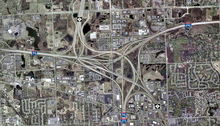
Another with a redundant south-west ramp is in the Berkeley suburb of St. Louis , Missouri. There, the inner belt expressway as meet Interstate 170 and Interstate 70 at 38 ° 43 '45 " N , 90 ° 19' 54" W .
Special and mixed forms
One-quadrant solution
The one-quadrant solution is a special case. At this motorway junction, only one quadrant is occupied by connecting ramps. In this way, intertwined routes result on both ramps, a turning drive is not possible at this motorway junction. An example of a one-quadrant solution is the Leverkusen-West motorway junction ( 51 ° 2 ′ 17 ″ N , 6 ° 58 ′ 1 ″ E ). The Kaiserberg cross ( 51 ° 26 ′ 31 ″ N , 6 ° 48 ′ 18 ″ E ) near Duisburg is essentially a one-quadrant solution.
This variant is more common in Japan and is suitable for positioning the toll station to connect toll-free and toll-free routes. A similar form with fewer overhangs, but space requirements in other quadrants, is the connection by two trumpets . This design can be found in almost all motorway junctions in Italy, which connect a toll motorway and a toll-free expressway.
Double trumpet
In Germany, fused double trumpets do not occur on motorways, as the autobahn branching off would lead away to the left and two flowing autobahns would mostly have the same name. Two trumpets can be found at the Gießener Nordkreuz and to connect them to motorways. The trumpet is the simplest height-free three-armed knot. A four-armed node can be built by stringing two three-armed nodes, if this meets the requirements of the traffic volume.
Line solution
The line solution is used when two motorways have an acute crossing angle. Numerous bridge structures are required for this motorway junction. There are no interwoven routes. Turning drives are not possible. Examples of a motorway junction with a line solution are the Hamburg-Ost junction ( A 1 and A 24 ) and the Sonnborner junction ( A 46 , A 535 and L 418 ).
Parallel unbundling
Belgian motorway junctions in particular are characterized by a special type of unbundling: two motorways to be connected are run in parallel for several kilometers. In contrast to the lanes, which are separated from one another by the usual long-striped markings, the two halves of the motorway in the parallel area are separated from one another by wide, short lines. You can change to the desired motorway up to their fork.
The same principle was chosen in Germany at the intersection of the north-south Autobahn 7 with the Autobahn 4 continuing to the east and the Autobahn 5 continuing to the west , in that the connection was established through the two Autobahn triangles Kirchheim and Hattenbach with a length of 4 km in between common roadway.
Another example is the junction of Autobahn 45 with Autobahn 66 north of Hanau. Between the Hanauer Kreuz and the Langenselbolder Dreieck, the motorway is four-lane, whereby the two outer lanes can be assigned to the A 66 and the inner ones to the A 45. The parallel route here is approximately 2.75 km long.
This form can also be found in Waiblingen . The federal highways 14 and 29 will be merged here and run parallel over approx. 750 m with four lanes. This branch is known as divider B 14 / B 29. Then the roads separate again into the B 14 towards Stuttgart and the two-lane junction to Fellbach / Stuttgart-Bad Cannstatt (old B 14).
Spaghetti knot
Crosses are referred to as spaghetti knots, the connecting ramps of which are guided in a complex manner, without clearly corresponding to any other named design. Such motorway junctions usually arise when the affected motorways intersect at an unfavorable angle, the available space is very limited or more than four motorway stretches meet. The routing of the ramps is confusing and does not follow a uniform scheme.
There are various examples of such motorway junctions such as E.g. the Kaiserberg cross near Duisburg , Échangeur de Loncin near Liège in Belgium or the Gravelly Hill Interchange near Birmingham in the United Kingdom .
The motorway junction of the French motorways Autoroute A42 and Autoroute A46 near Lyon ( 45 ° 48 ′ 3 ″ N , 4 ° 55 ′ 38 ″ E ) is a special form of spaghetti knot, whereby this cross basically consists of two motorway triangles that are connected by a 300 m long bridge over the Rhone .
Motorway junction with motorway fork
A five branch branch is in Houston , Texas . At 29 ° 46 ′ 32 ″ N , 95 ° 15 ′ 51 ″ W , based on the design of the Maltese cross, Interstates 10 and 610 cross and connect US 90 . More than four-armed branches do not have any ramps for the most acute-angled turns, based on the direction of destination (this is the fork ). Unless appropriately developed, they have a strong dense effect on traffic, as the individual vehicle occupies two lanes when it comes to changing lanes. They also attract the flow of traffic, but represent the slightest detour. They can be relieved by installing several parallel ramps. An example of this is the junction of M8 with twelve ramps on the north-eastern part of the Moscow ring road at 55 ° 52 '56 " N , 37 ° 43' 33" O .
The Aachen motorway junction has five arms, a clover leaf with a fork. The reorganization of the unbundling will take until the end of 2020 (as of spring 2019). It intersects A 4 to the A 44 . The A 544 also begins here
Mixture of Maltese and Turbine
A variant of the half-Maltese half-turbine can be found in Japan southeast of the city of Nagoya . Here the Tōmei Expressway crosses the Isewangan Expressway or Tokai Loop Expressway . See: 35 ° 1 ′ 16 ″ N , 137 ° 8 ′ 51 ″ E
history
The invention of the plan-free crossing goes back to the American civil engineer Arthur Hale , whose clover-leaf cross was registered with the patent office on February 29, 1916. It also includes the further approach of connecting the two bridged roads with four connecting roads. This corresponds to Dutch ramps with oncoming traffic. The curves of this design are designed with 45 ° and 135 ° for low speeds only.
In Europe , the Swiss Willy Sarbach is considered to be the inventor, who in 1927 presented plans for a “clover leaf” at a motorway exhibition in Basel as an answer to HAFRABA's price question for a solution for the “crossing-free intersection” of two expressways, which on October 15, 1928 as Patent registered.
Independently of this, Edward Delano from Philadelphia , inspired by the traffic management in Buenos Aires , in which instead of turning right (there was left-hand traffic) by turning a block three times to turn right, the same concept was presented. In 1928 this led to the construction of the world's first real motorway interchange at Woodbridge , New Jersey . It was opened in 1929 and today connects the US-1 and US-9 with the NJ-SR-35, the former NJ-SR-4, on the route of the old NJ-SR-25. The now converted transport nodes is 40 ° 34 '18 " N , 74 ° 17' 34" W .
In the 1930s, when the construction of motorways was being planned on a large scale in Germany, the topic of motorway junctions became topical. In 1936 the Schkeuditzer Kreuz near Leipzig was opened as the first motorway interchange in Europe and was completed in 1938.
The Kamener Kreuz was inaugurated in 1937 and had no function at that time as the A1 was not yet completed. It was not until 1965 that the motorway junction, built as a clover leaf, was fully operational.
The Frankfurter Kreuz was designed as early as 1933 and provisionally laid out from 1939 to 1941, but could not be completed until after the Second World War and was opened to traffic on July 10, 1956 by the then Transport Minister Hans-Christoph Seebohm .
Faux motorway junctions
In Germany there are some intersections of autobahns with four-lane, autobahn-like expressways that are not classified as autobahns and that are signposted as autobahn intersections. Examples are the Wörther Kreuz , the Nürnberg-Hafen intersection, the Seelhorst intersection , the Augsburg-West intersection , where the A 8 and the B 2 or B 17 intersect, and the Oggersheim intersection , as well as the Stuttgart-Zuffenhausen intersection , where the A 81 and the B 10 intersect. There is also a connection at the A 5 - exit 54 Appenweier to the motorway-like B 28 . The exit is also known as the motorway junction and is shaped like a clover . The Sonnborn Cross in Wuppertal is a hybrid . It is a real motorway junction because it connects the A 46 with the A 535 , but the motorway-like expressways L 74 and L 418 are also integrated into the junction. Furthermore, the connection of the B 96 to the A 10 and the A 111 is designated as the Oranienburg motorway junction , which is known as this due to the growing infrastructure.
However, not all intersections between motorways and four-lane expressways are so designated. For example, the Stuttgart-Degerloch junction (intersection of the A 8 with the motorway-like B 27) has no such name. Due to its earlier form, it only got the colloquial name " Echterdinger Ei ". The construction of the Wetzlar-Ost junction is similar to that of a motorway junction, because the A 45 and the four-lane B 49 cross there. The junction is in the shape of a clover leaf. What is confusing here is that on some road maps it is referred to as “Autobahnkreuz Wetzlar-Ost”, in others it is only referred to as “Junction Wetzlar-Ost”.
See also
Web links
- Ágnes Lindenbach: Plan-free nodes. (PDF; 410 kB) Lecture 2, Roads and Railways II. BMEEOUV-N40. Budapest University of Technology and Economics, SS 6–9 , archived from the original on July 5, 2015 ; accessed on March 15, 2017 .
- Motorway junctions & motorway triangles in Germany (database with map and aerial photo data) ( Memento from March 30, 2016 in the Internet Archive ) (in archive.org)
- Text42: On the beauty of the motorway junctions
- Veronika Bock and Ulrich Biermann: 02/29/1916 - Patent for the WDR ZeitZeichen motorway junction (podcast).
Individual evidence
- ↑ Numbers and dates. The motorway network of the Federal Republic of Germany. Retrieved January 26, 2017.
- ↑ https://www.openstreetmap.org/#map=14/51.0295/6.4765 .
- ↑ https://www.openstreetmap.org/#map=16/51.2471/12.3950
- ↑ https://www.openstreetmap.org/#map=15/53.5250/8.0083
- ↑ Planning approval decision for the conversion of the Neufahrn motorway junction (PDF; 257 kB).
- ↑ a b c Institute for Roads and Railways at KIT: Design and Construction of Roads - Part: Road Design. (PDF; 8.44 MB). Retrieved September 7, 2013.
- ↑ Coordinates Knooppunt “Prins Clausplein” .
- ^ Coordinates Thorney Interchange .
- ↑ Coordinates of the Wetzlar Cross .
- ↑ Coordinates of the Köln-Ost motorway junction .
- ↑ Reconstruction of the Leverkusen motorway junction, project information at Straßen.NRW
- ↑ Texas Department of Transportation: Dallas' First Five Level Interchange. July 2001, accessed March 9, 2013.
- ↑ ODOT: Right-In Right Out channelization. 4th-7th October 1998.
- ↑ RightInOutTurnlane. (PDF) Missouri Department of Transportation, archived from the original on December 15, 2013 ; accessed on August 25, 2019 .
- ^ The volleyball. On: kurumi.com.
- ^ Dror Bar-Natan: An interchange near Baltimore. Retrieved November 13, 2013.
- ^ Aachen motorway junction - the project. State Office for Road Construction NRW, accessed on April 5, 2019 .
- ↑ Patent 1173505 at Google Patent Search.
- ^ Joseph Nathan Kane : Famous First Facts. HW Wilson Company, 2006, ISBN 0-8242-1065-4 , p. 222 English .
Remarks
- Google Earth contains aerial imagery on the subject. Historical aerial photographs are not available in the mobile version and the Earth plug-in of Google Maps .






